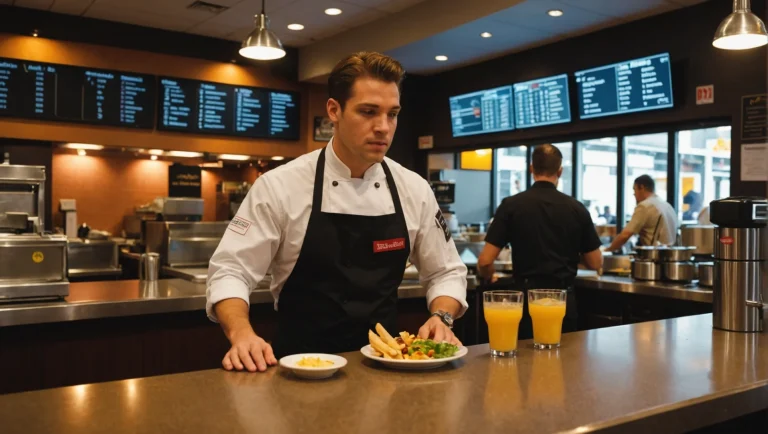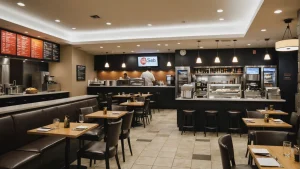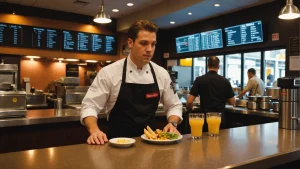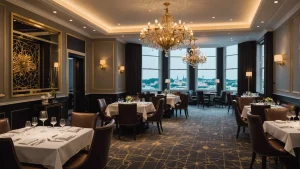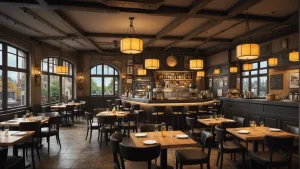Counter-service restaurants are a popular choice for business owners looking to streamline operations and reduce labor costs. In this comprehensive guide, we’ll explain exactly what a counter-service restaurant is, explore the advantages and challenges of this business model, and provide best practices for setting up and managing your successful counter-service establishment.
Whether you’re a seasoned restaurateur or a first-time business or restaurant owner, this article will give you the insights and strategies you need to thrive in the fast-paced world of counter-service dining.
What is a Counter Service Restaurant?
-
Counter-service restaurants are where customers order, pay, and receive food at a counter
-
Customers typically seat themselves after receiving their food
-
Examples include fast-food chains, casual dining establishments, and cafes/coffee shops
Counter service restaurants are food establishments where customers order, pay for, and receive their food at a counter, as opposed to being served by waitstaff at a table. After receiving their food, customers typically find their seating in the dining area. This counter-service restaurant model streamlines the ordering process and reduces labor costs by eliminating the need for a full waitstaff. Curious about the nuances of fast dining options? Delve into how a counter service restaurant streamlines its operations for speedy and efficient service.
Counter-service restaurants come in various forms, each catering to different customer needs and preferences. Understanding the distinctions between these types can help business owners decide which model best suits their concept and target audience. For those looking for reliable logistics support, consider exploring our Philadelphia courier services. They can enhance your counter-service restaurant’s delivery capabilities and streamline operational efficiency as you grow your business.
Examples of Counter-Service Restaurants
Many well-known establishments fall under the counter-service model, including:
-
Fast food chains like McDonald’s, Burger King, and Subway
-
Casual dining establishments like Panera Bread and Chipotle
-
Cafes and coffee shops like Starbucks and Dunkin’ Donuts
These businesses have successfully adapted the counter service model to their specific niches, offering customers quick and convenient meals, and affordable dining options.
Types of Counter-Service Restaurants
While all counter service restaurants share the basic premise of customers ordering and paying at a counter, there are several distinct types, each with its own characteristics and target audience. Delve into the variety of counter service establishments and select the ideal type that meets your dining preferences.
Fast Food Restaurants
Fast food restaurants prioritize speed and affordability, making them popular choices for customers seeking quick, inexpensive meals. These establishments typically offer a limited menu with standardized offerings, allowing them to optimize their operations for efficiency. Customers of fast-food establishments can expect minimal wait times and consistent food quality across locations.
For example, McDonald’s is known for its signature Big Mac, while Burger King is famous for its Whopper. These iconic menu items are staples of the fast food industry and contribute to the convenience and consistency that customers expect from these establishments.
Fast Casual Restaurants
Fast casual restaurants bridge the gap between fast food and traditional casual dining. These establishments offer higher-quality ingredients and more diverse menu options than fast food restaurants, while still maintaining the convenience food prices and speed of counter service. Fast casual restaurants often feature healthier options and customizable dishes, appealing to customers who are willing to pay slightly higher prices for better quality food.
Chipotle, for instance, is a popular fast-casual chain that emphasizes the use of fresh, sustainable ingredients and allows customers to customize their meals with various toppings and sauces. This focus on quality and customization has helped Chipotle establish a loyal customer base.
Cafes and Coffee Shops
Cafes and coffee shops primarily focus on serving coffee, tea, and light fare such as pastries, sandwiches, and salads. These establishments often foster a relaxed, inviting atmosphere that encourages customers to stay longer and socialize or work. Many cafes and coffee shops now offer free Wi-Fi and ample seating, making them popular spots for remote workers, students, and community gatherings.
The ambiance of cafes and coffee shops plays a crucial role in attracting and retaining customers. By providing a comfortable environment, these establishments can create a sense of community and encourage customers to linger, increasing the potential for additional sales and fostering customer loyalty.

Delivery notifications and tracking improve customer satisfaction by 27%.
Metrobi automatically notifies your receivers of ETAs, provides delivery tracking, and collects delivery feedback.
Counter Service Restaurant Business Model Explained
-
Counter-service restaurants streamline operations and reduce labor costs
-
Customers order and pay at the counter, then receive their food at the counter or a designated pickup area
-
This model is popular among fast-casual and quick-service restaurants
Counter-service restaurants often have: For those looking to enhance their counter-service model, partnering with a reliable service can streamline operations further. Metrobi specializes in providing delivery solutions tailored for businesses, including efficient meal prep logistics. You can explore how they can support your restaurant’s delivery needs for optimal service and customer satisfaction.
Limited Menu Options
Counter-service restaurants typically offer a focused menu with a limited number of items. This allows for faster preparation times and simplifies the ordering process for customers. By concentrating on a specific cuisine or a few signature dishes, these establishments can optimize their inventory and reduce food waste. For businesses like counter-service restaurants looking to enhance their logistics, utilizing a reliable delivery service can be invaluable. Leveraging a professional courier service in Miami can help manage deliveries efficiently, allowing restaurant owners to focus more on their core operations and customer satisfaction.
Having a limited menu also enables the kitchen staff to specialize in preparing specific items, ensuring consistent quality and efficiency. This specialization can lead to faster turnaround times, as the staff becomes more proficient in preparing the same dishes repeatedly.
Examples of successful counter-service restaurants with limited menus include In-N-Out Burger and Shake Shack, which have optimized their menus to ensure efficiency and consistency.
Streamlined Kitchen Operations
The counter service model allows for a more efficient kitchen layout and workflow. Since customers place their orders at the counter, the kitchen can focus on preparing food without the need for a large wait staff. This streamlined process reduces the number of employees required, leading to lower labor costs.
In a counter-service restaurant, the kitchen is often visible to customers, creating an open and transparent environment. This visibility can help build trust with patrons, as they can see their food being prepared fresh and quickly.
Counter-service restaurants invest in specialized equipment that enables faster cooking times and consistent results. This may include high-capacity fryers, rapid-cook ovens, and automated dispensers for beverages and sauces.
The kitchen layout is designed for optimal efficiency, with dedicated stations for each task, such as grilling, assembling, and packaging. This assembly line approach minimizes bottlenecks and ensures a smooth flow of orders from the counter to the kitchen and back to the customer.
Advantages of the Counter Service Model
The counter service restaurant model offers several benefits for restaurant owners and customers alike:
By eliminating the need for a large wait staff, counter service restaurants can significantly reduce their labor costs. Fewer employees are required to operate the restaurant, as the focus is on food preparation and counter service. This reduction in labor costs can lead to higher profit margins and more competitive pricing for customers.
Counter-service restaurants are designed for speed and efficiency. Customers can quickly place their orders, pay, and receive their food without the need for a server. This faster service leads to higher customer turnover, as patrons can enjoy their meals and leave promptly, making room for new customers.
The increased turnover rate allows counter-service restaurants to serve more customers during peak hours, maximizing revenue potential.
With a streamlined business model, counter-service restaurants have simpler operations compared to full-service establishments. Employees require less training, as their roles are more focused and specialized. This simplification reduces the time and resources needed to onboard new staff members and ensures consistency in service and product quality.
Challenges of the Counter Service Model
While the counter-service model offers numerous advantages, it also presents some challenges:
In a counter service setting, there are fewer opportunities for staff to upsell menu items or suggest additional purchases. The brief interaction between customers and offer counter service, staff may not allow for the same level of suggestive selling that a full-service restaurant can provide.
To mitigate this challenge, counter-service restaurants can strategically place impulse-purchase items near the counter or use digital menu boards to highlight promotional items and combos.
The counter-service model prioritizes speed and efficiency over personalized service. Customers have limited interaction with staff, which may not suit patrons seeking a more engaging and personalized dining experience.
However, counter-service restaurants can still foster a friendly and welcoming atmosphere by training staff to be attentive, helpful, and efficient during their brief encounters with customers.
During peak hours, counter service restaurants may experience longer lines, as customers queue up to place their orders. These lines can be intimidating for some patrons and may lead to lost business if wait times become excessive. To further enhance customer satisfaction, many businesses are turning to solutions like a reliable same-day delivery service. Discover how adopting a Washington DC same-day delivery solution can help streamline operations and meet customer demands by offering convenience beyond the restaurant’s premises.
To combat this issue, restaurants can implement queue management systems, such as mobile ordering apps or self-service kiosks, to help disperse crowds and reduce wait times. Additionally, optimizing the menu and kitchen operations can help ensure that orders are processed quickly and efficiently.
Setting Up a Counter Service Restaurant for Success
Designing an Efficient Kitchen Layout
An efficient kitchen layout is crucial for the success of a counter-service restaurant. The goal is to optimize the flow of the kitchen to ensure quick order preparation and minimize delays. This involves carefully planning the placement of equipment, workstations, and storage areas.
When designing your kitchen, consider the following factors:
Workflow
Analyze the path that ingredients and orders will take from the moment they enter the kitchen until they are served to the customer. You can arrange equipment and workstations in a logical sequence to minimize unnecessary movement and reduce the risk of bottlenecks.
Equipment Placement
Position key equipment, such as grills, fryers, and ovens, near the corresponding prep areas. This will allow kitchen staff to work efficiently and collaborate effectively. You can ensure that there is adequate space around each piece of equipment for safe and comfortable operation.
Storage
Allocate sufficient space for ingredient storage and prep. This includes refrigerators, freezers, and dry storage areas. It is better to organize storage areas based on the frequency of use, with frequently used items easily accessible to kitchen staff. Proper storage will help maintain ingredient quality and freshness while minimizing waste.
Creating a User-Friendly Ordering System
In a counter-service restaurant, the ordering process is a critical touchpoint for customers. A user-friendly ordering system can greatly enhance the customer experience and increase efficiency. There are several options to consider when implementing an ordering system:
Clear and well-designed menu boards are essential for helping customers quickly understand their options and make decisions. You can use high-quality images and easy-to-read fonts to showcase your offerings. Consider using digital menu boards, which allow for easy updates and customization.
Self-service ordering kiosks can streamline the ordering process and reduce wait times. Customers can browse the menu, customize their orders, and pay directly at the self-ordering kiosk. This technology can also help upsell by suggesting complementary items or promotions. This can be achieved using Windows lockdown mode, which locks the device to a single app for a secure and seamless ordering experience.
Implementing a mobile ordering system allows customers to place orders and pay through their smartphones. This can be particularly useful for customers who want to avoid waiting in line or prefer a contactless ordering experience.
Regardless of the ordering system you choose, it’s crucial to train your staff to process orders quickly and accurately. This involves ensuring that they are familiar with the menu, can make recommendations at the order point, and can troubleshoot any issues that may arise.
Developing a Strong Brand Identity
A strong brand identity is essential for attracting customers and setting your counter service restaurant apart from competitors. Your brand should reflect your unique value proposition and resonate with your target audience.
You can create a memorable logo and visual style that accurately represents your brand. This includes choosing a color palette, font, and imagery that will be used consistently across all customer touchpoints, such as signage, packaging, and marketing materials.
It is best to develop a brand voice that aligns with your target audience and reflects your brand’s personality. This voice should be consistent across all communication channels, including social media, website copy, and in-store interactions.
You can ensure that your brand identity is reflected in every aspect of the customer experience. This includes the design of your restaurant interior, the attitude and appearance of your staff, and the quality of your food and packaging. Consistency is key to building a strong brand reputation and fostering customer loyalty.
Differentiating Between Counter Service and Self-Service
While both counter-service and self-service restaurants involve customers placing their orders, there are some key differences between the two:
-
In a counter service restaurant, customers order and pay at a counter, and their food is then prepared and served to them by staff. This model allows for a higher level of customer interaction and the opportunity for staff to upsell or make recommendations. Discover what sets a counter service restaurant apart from a fine dining establishment and the unique charm it brings to the dining experience.
-
In a self-service restaurant, such as a buffet or salad bar, customers serve themselves from a selection of pre-prepared dishes. This model requires less staff and can be more cost-effective, but offers less opportunity for personalized service.
When deciding between counter service and self-service, consider your target audience, the type of cuisine you offer, and your overall brand identity. Counter-service tends to be more suitable for restaurants offering made-to-order dishes, while self-service can work well for establishments with a focus on variety and value.
Advantages of Running a Counter Service Restaurant
-
Lower labor costs due to fewer employees and streamlined operations
-
Higher sales volume and customer turnover, leading to increased profits
-
Simplified menu and service model for easier employee training and management
Reduced Labor Costs
Counter-service restaurants require fewer employees compared to full-service establishments. With customers placing orders at the counter and picking up their food, there’s no need for a large waitstaff. This translates to lower labor costs, as counter staff typically earn less than servers who rely on tips.
With a counter-service setup, restaurants can operate efficiently with a smaller team. Roles are often consolidated, with employees multitasking between taking orders, preparing food, and handling transactions. This streamlined staffing approach not only cuts costs but also simplifies scheduling and management.
Increased Sales Volume
Counter-service restaurants often experience higher customer turnover rates than full-service establishments. The quick, casual nature of the table service restaurant model allows for more customers to be served per hour. This is particularly advantageous during peak hours, such as lunch rushes or busy weekends.
To maximize sales volume, counter-service restaurants should focus on optimizing their operations during peak hours. This may involve adjusting staffing levels, streamlining the menu, and ensuring efficient kitchen processes. By serving more customers quickly and effectively, businesses can capitalize on the increased turnover rate.
Simplified Operations
Counter-service restaurants typically offer a more streamlined menu and service model compared to full-service establishments. This simplification can lead to several operational advantages.
First, a focused menu allows for more efficient food preparation and inventory management. With fewer dishes to prepare, kitchens can optimize their processes and reduce waste. This can result in lower food costs and higher profit margins.
Second, the simplified self-service model requires less complex training for employees. Staff can be quickly trained on the menu, POS system, and customer service basics. This reduces the time and resources needed for onboarding and ongoing training.
By narrowing their focus, counter-service restaurants can become specialists in their chosen cuisine or concept. This specialization allows for greater efficiency and consistency in both food quality and service.
For example, a counter service burger joint can perfect its recipes, optimize its kitchen layout, and train staff to excel in a specific set of tasks. This level of specialization can lead to a loyal customer base and a strong reputation in the market.
As you can see, counter-service restaurants offer several compelling advantages for business owners. From reduced labor costs to increased sales volume and simplified operations, this quick-service restaurant model can be a profitable choice for the right concept and location. In the next section, we’ll explore best practices for managing a counter-service restaurant to ensure long-term success.
Best Practices for Managing a Counter-Service Restaurant
Managing a counter-service restaurant requires a focus on efficiency, customer service, and maintaining high standards. By implementing best practices in these areas, restaurant owners can create a successful and profitable business.
Optimize Your Menu for Efficiency
A well-designed menu is crucial for the success of a counter-service restaurant. Focus on offering a core set of popular, easy-to-prepare items that can be served quickly without compromising quality
Regularly it is better to review and update your menu based on sales data and customer feedback. You can remove items that aren’t selling well and consider adding new offerings that align with current trends and customer preferences.
Invest in Staff Training and Retention
Your staff is the face of your restaurant and plays a critical role in customer satisfaction. Provide thorough training on food preparation, food safety, and customer service to ensure that your team is equipped to deliver a high-quality and pleasant guest experience.
You can offer competitive wages and benefits to attract and retain top talent. Consider implementing employee incentive programs or career development opportunities to keep your team motivated and engaged.
Prioritize Cleanliness and Sanitation
Maintaining a clean and sanitary environment is essential for any restaurant, but it’s particularly important in a counter service setting where customers can see the food preparation area. You can develop strict cleaning and hygiene protocols and train your staff to follow them consistently.
“Cleanliness is non-negotiable in the restaurant industry,” says Dr. Mark Davis, a food safety expert. “Regularly sanitizing surfaces, properly storing food, and ensuring that employees follow proper handwashing procedures can help prevent the spread of foodborne illnesses and protect your customers and your reputation.”
Regularly inspect and maintain your equipment to ensure it functions properly and meets safety standards. Schedule deep cleaning and maintenance tasks during off-hours to minimize disruptions to your operations.
By focusing on these best practices, counter-service restaurant owners can create an efficient, customer-focused business well-positioned for success in the competitive food service industry.
Your Roadmap to Counter and Table Service Success
Counter-service restaurants offer a streamlined, efficient model for serving customers quickly and cost-effectively. By focusing on a core menu, service efficiency, optimizing kitchen layout, and investing in staff training, you can create a thriving business that meets the needs of today’s fast-paced consumers.
The key to success lies exactly the right people and in striking the right balance between speed, quality, and customer satisfaction. By prioritizing cleanliness, consistency, and a strong brand identity, you can build a loyal customer base and stand out in a competitive market.
Are you ready to take your counter-service restaurant to the next level? Start by reviewing your menu, assessing your operations, and identifying areas for improvement. Then, develop a plan of action that encompasses staff training, marketing, and customer service.
With dedication, hard work, and a commitment to excellence, you can create a counter-service restaurant that survives and thrives in the years to come.

